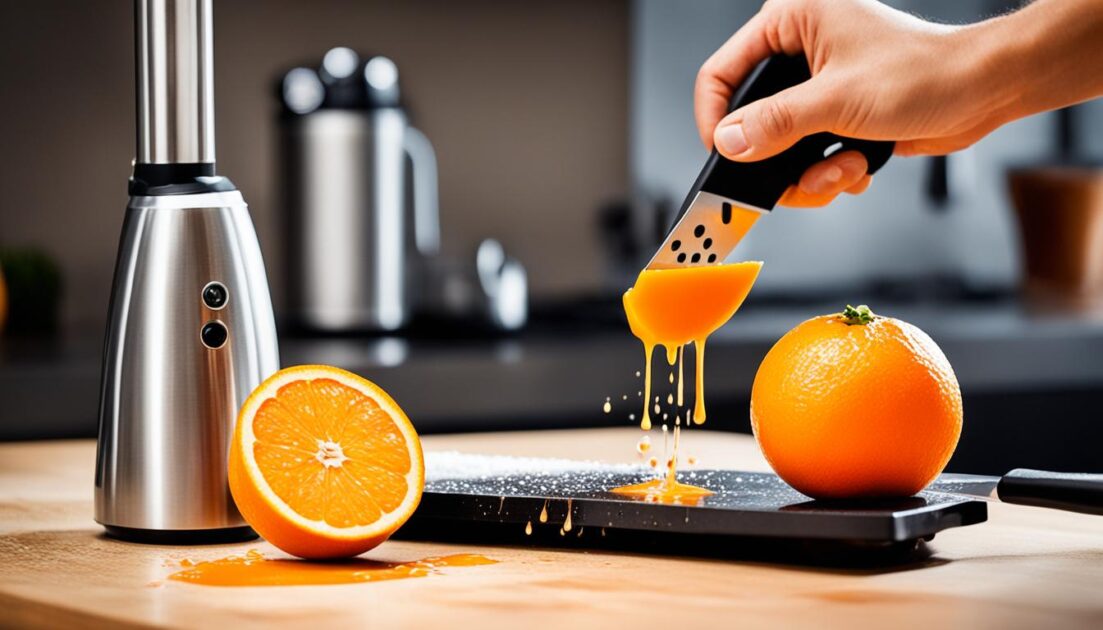Vitamin C is an essential ingredient in skincare, renowned for its anti-aging properties. It promotes collagen production, fades hyperpigmentation, and acts as a powerful antioxidant. However, incorporating vitamin C into skincare products can be challenging due to its instability in water-based formulations. To address this, commercial serums stabilize vitamin C with additional ingredients like vitamin E and ferulic acid. But did you know that you can make your own vitamin C serum right at home? Not only does it allow for customization, but it is also cost-effective.
Key Takeaways:
- Homemade vitamin C serums can be easily made at home, allowing for customization and cost-effectiveness.
- Vitamin C is unstable in water-based products, but stabilizing ingredients like vitamin E and ferulic acid can improve its stability.
- Creating your own vitamin C serum requires specific ingredients and materials, such as L-ascorbic acid powder, distilled water, and airtight containers.
- It is important to store the serum properly, conduct sensitivity tests, and use the serum within the recommended time frame for maximum effectiveness.
- While DIY vitamin C serums offer benefits, such as customization and potentially higher effectiveness, they may lack supporting ingredients found in commercial products.
The Problem with Vitamin C in Skincare
L-ascorbic acid, the most common form of vitamin C used in skincare, is highly unstable in water-based products. It quickly degrades into yellow dehydroascorbic acid (DHA) and other products. Stabilizing L-ascorbic acid with vitamin E and ferulic acid improves its stability. However, this requires additional ingredients like an emulsifier to mix vitamin E with water. Preservatives are also necessary to prevent bacterial growth and extend the shelf life of the serum.
DIY Vitamin C Serum Recipe
Creating your own DIY vitamin C serum is a simple process that requires just a few basic ingredients and materials. By following this recipe, you’ll be able to harness the power of vitamin C in your skincare routine.
Gather the following ingredients and materials:
- L-ascorbic acid powder
- Distilled water
- Baking soda
- pH strips
- A 1/4 teaspoon measuring spoon
- An airtight container
- Aluminum foil
The exact measurements of each ingredient will depend on the desired concentration of vitamin C in your serum. It’s recommended to start with a lower concentration and gradually increase it based on your skin’s tolerance.
Follow these steps to create your DIY vitamin C serum:
- Dissolve the L-ascorbic acid powder in distilled water. Use the 1/4 teaspoon measuring spoon to ensure accurate measurements.
- Add a small amount of baking soda to adjust the pH of the serum. Use the pH strips to test the pH level and ensure it falls within the desired range of 2.5-3.5 for optimal effectiveness.
- Transfer the serum to an airtight container to prevent oxidation and degradation. It’s recommended to use a dark-colored container to protect the serum from light exposure, which can compromise its stability.
- Wrap the container with aluminum foil to provide additional protection from light.

By following this recipe, you’ll be able to create your own DIY vitamin C serum that is tailored to your needs. Remember to store the serum in a cool, dark place to maintain its potency.
Homemade Moisturizing Vitamin C Serum Recipe
For those with dry or aging skin, a moisturizing vitamin C serum can be beneficial. This homemade serum combines the benefits of vitamin C powder, distilled water, vegetable glycerin (or non-comedogenic oil), vitamin E oil, and essential oil for fragrance.
To make the serum, you will need:
- Vitamin C powder
- Distilled water
- Vegetable glycerin or non-comedogenic oil
- Vitamin E oil
- Essential oil for fragrance (optional)
- Mixing bowl
- Whisk
- Funnel
- Glass container
To prepare the serum:
- In a mixing bowl, combine 1/2 teaspoon of vitamin C powder with 1 tablespoon of distilled water. Stir until the vitamin C powder is completely dissolved.
- Add 1 teaspoon of vegetable glycerin or non-comedogenic oil to the mixture and whisk until well combined.
- Next, add a few drops of vitamin E oil for extra hydration and antioxidant benefits. You can also add a few drops of your preferred essential oil for a pleasant fragrance.
- Whisk the ingredients together until they are well blended and have a smooth consistency.
- Using a funnel, transfer the serum into a glass container. Choose a dark-colored container to protect the serum from light exposure, which can degrade the vitamin C.
This homemade moisturizing vitamin C serum should be stored in the refrigerator to maintain its freshness and effectiveness. Due to the absence of preservatives, it is recommended to use the serum within three days to ensure maximum potency.

Benefits of Homemade Moisturizing Vitamin C Serum
The homemade moisturizing vitamin C serum offers several benefits for dry or aging skin:
- Hydration: The combination of vegetable glycerin or non-comedogenic oil and vitamin E oil helps to moisturize and nourish dry skin, resulting in a healthier and more supple complexion.
- Antioxidant protection: Vitamin C, vitamin E, and essential oils provide antioxidant properties, helping to neutralize free radicals and protect the skin from environmental damage.
- Brightening effects: Regular use of vitamin C serums can help brighten the skin and even out skin tone, reducing the appearance of dark spots and hyperpigmentation.
- Anti-aging benefits: Vitamin C stimulates collagen production, which helps to improve skin elasticity and reduce the appearance of fine lines and wrinkles.
- Customization: By making your own serum, you have the flexibility to adjust the ingredients and their proportions according to your skin’s needs.
- Cost-effectiveness: Homemade serums are often more budget-friendly compared to store-bought versions, allowing you to enjoy the benefits of vitamin C without breaking the bank.
However, it’s important to note that homemade serums lack the additional supporting ingredients found in commercial products, such as penetration enhancers and additional antioxidants. Additionally, the absence of preservatives increases the risk of contamination and the need to remake the serum frequently.
Proper Storage and Testing of Vitamin C Serum
Properly storing your vitamin C serum is crucial to maintain its effectiveness and reap the benefits it offers for your skin. When stored correctly, the serum can last longer and deliver optimal results. Additionally, conducting a patch test before regular use ensures that the serum suits your skin and avoids any adverse reactions.
Storing Vitamin C Serum
One of the key factors in preserving the potency of your vitamin C serum is refrigeration. Storing the serum in the refrigerator helps retard oxidation, preventing it from losing its effectiveness. The cool temperature helps maintain the integrity of the active ingredients and extends the shelf life of your serum.
Testing on a Patch of Skin
Prior to applying the serum to your entire face, it is crucial to perform a patch test. This involves applying a small amount of the serum on a small patch of skin, such as the inside of your wrist or behind the ear. Leave it on for 24 hours and observe for any signs of redness, rash, irritation, or discomfort. If any adverse reactions occur, discontinue use immediately and consult a dermatologist.
Shelf Life
Vitamin C serums have a limited shelf life, especially when prepared at home. Basic serums should be used within two weeks, while moisturizing serums, which contain additional ingredients like vegetable glycerin and oils, should be used within three days. Using the serum beyond the recommended period may lead to a loss of potency and reduced effectiveness. To maximize the benefits, it is essential to adhere to the recommended usage timeframes.
In summary, proper storage of vitamin C serum is crucial in maintaining its effectiveness and prolonging its shelf life. Remember to refrigerate the serum, perform a patch test before use, and adhere to the recommended usage timeframes for optimal results.
Benefits and Considerations of DIY Vitamin C Serums
DIY vitamin C serums offer a range of benefits and considerations to keep in mind when incorporating them into your skincare routine. Here are some key points to consider:
- Customization: One of the main advantages of DIY vitamin C serums is the ability to customize the formulation to suit your specific skincare needs. You can adjust the concentration of vitamin C to cater to your skin’s tolerance and target specific concerns.
- Cost-effectiveness: Making your own vitamin C serum can be significantly more cost-effective compared to purchasing store-bought products. The ingredients required for DIY serums are often readily available and affordable, making it a budget-friendly option.
- Effectiveness compared to store-bought products: DIY vitamin C serums can potentially offer higher effectiveness compared to store-bought products. This is because commercial serums often contain additional ingredients that may dilute the concentration and potency of vitamin C.
“Customization and cost-effectiveness make DIY vitamin C serums a popular choice for skincare enthusiasts looking for tailored solutions without breaking the bank.”
Despite the benefits, DIY vitamin C serums do have some downsides to consider:
- Lack of supporting ingredients: DIY serums may lack supporting ingredients typically found in commercial products. These include penetration enhancers and antioxidants that can enhance the efficacy and stability of vitamin C.
- Need for remaking: DIY serums often need to be remade more frequently compared to commercially available options. This is due to the potential instability of the vitamin C formulation over time, leading to a decrease in effectiveness.
- Risk of contamination: As with any homemade product, there is a risk of microbial contamination if proper hygiene practices are not followed during the creation and storage of the serum.
- Risk of procedure error: DIY vitamin C serums require precise measurements and proper mixing techniques. Mistakes and errors during the procedure can affect the effectiveness or safety of the serum.
Considering these factors, it’s important to weigh the benefits and considerations when deciding whether DIY vitamin C serums are the right choice for your skincare routine.

| Benefits | Considerations |
|---|---|
| Customization | Lack of supporting ingredients |
| Cost-effectiveness | Need for remaking |
| Effectiveness compared to store-bought products | Risk of contamination |
Tips for Using Vitamin C Serums
When incorporating vitamin C serums into your skincare routine, it is important to follow a few key tips to maximize their effectiveness. Firstly, cleanse your face thoroughly before applying the serum. This ensures that your skin is free from dirt, oil, and impurities, allowing the serum to penetrate better.
Once your skin is clean, apply a moisturizer to hydrate and nourish your skin. This step provides a protective barrier and enhances the absorption of the serum. After moisturizing, gently apply the vitamin C serum to your face and neck, using upward motions to promote circulation and absorption.
When starting with vitamin C serums, it is recommended to use them twice daily. However, if you have sensitive skin, it is best to begin with less frequent use, such as every other day, to allow your skin to adjust. This also helps you check for any adverse reactions or sensitivity.
Lastly, remember to store your vitamin C serum properly to maintain its potency. Follow the recommended storage times, which typically ranges from two weeks for a basic serum to three days for a moisturizing serum. Maintaining the serum’s freshness and efficacy ensures that you get the most out of your skincare routine.
FAQ
How to make DIY vitamin C serum?
To make DIY vitamin C serum, you will need L-ascorbic acid powder, distilled water, a 1/4 teaspoon measuring spoon, baking soda to adjust pH, pH strips, an airtight container, and aluminum foil for light protection. Dissolve L-ascorbic acid in water, adjust the pH, and store the serum in a dark container.
What are the ingredients needed for a moisturizing vitamin C serum?
To make a moisturizing vitamin C serum, you will need vitamin C powder, distilled water, vegetable glycerin or non-comedogenic oil, vitamin E oil, and essential oil for fragrance.
How should I store vitamin C serum?
It is recommended to store vitamin C serum in the refrigerator to prolong its shelf life and prevent oxidation. Make sure to use dark containers and avoid exposure to light.
Can I use a DIY vitamin C serum on sensitive skin?
Individuals with sensitive skin should do a patch test before using a DIY vitamin C serum. Start with less frequent use to test for any adverse reactions.
What are the benefits of DIY vitamin C serums?
DIY vitamin C serums offer customization, cost-effectiveness, and potentially higher effectiveness compared to store-bought products. You have control over the ingredients and concentrations used.
Are there any downsides to DIY vitamin C serums?
DIY vitamin C serums require frequent remaking, lack supporting ingredients found in commercial serums, and carry a risk of microbial contamination. There is also a slight risk of making errors during the preparation process.
How should I use vitamin C serums?
Apply vitamin C serums after cleansing and moisturizing your skin. If you have sensitive skin, start with less frequent use and gradually increase. Follow the recommended storage times to ensure effectiveness.






